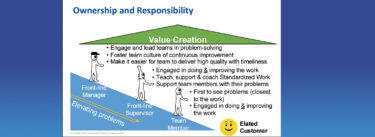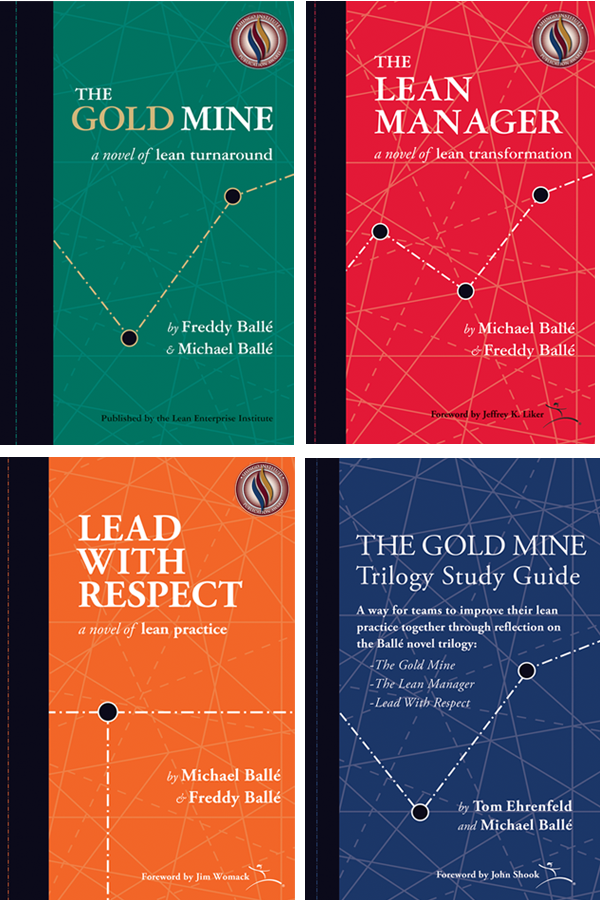Attempts to define lean leadership and to establish how to lead as an abstract or prescribed set of behaviors, invariably err from the very start—undermined by a fundamental misconception about the essence of leadership and where it is generated in a lean system. Not externally, not as a code or neat set of principles. But rather, like anything that is essential to lean, something that is part and parcel of the work at every level of the organization.
The thinking and practice of lean leadership always entails, first and foremost, thorough grasping of the situation. Thorough grasping of the situation, in turn, is always comprised of grasping:
- The external environment; the market, the customer, the enemy, the changing circumstances of conducting business
- The internal environment; the capabilities and conditions of the employees, partners, all members of the team, and conditions of the organization itself
- Oneself; the leader himself or herself is also an integral piece of the overall dynamic situation to be grasped. Leaders face the vexing challenge of being passionate and dispassionate at the same time: Passionate about attaining the goals and objectives of the organization and about fulfilling one’s responsibilities as leader; dispassionate about assessing the situation to determine direction and next steps.
All this calls for development of a radically different set of skills, a different thinking or mindset, than required by traditional modes of leadership behavior such as is taught in American business schools and championed in popular literature. The thinking and skills demanded by the new paradigm focus less on providing the right solution and more on providing the right questions, which, addressed with rigor, determine direction and dynamic course correction as materialized in specific action.
That different type of leadership – defined by thorough grasping of the situation and dynamic course correction that is enabled by disciplined organizational capability – requires, among other things, knowledge of these four dimensions:
- Knowledge of the purpose of the business, of its objectives, and environment
- Knowledge of the work to be done, to attain those objectives
- Knowledge of the capabilities of the organization, its strengths, its struggles, its weaknesses, and its current levels of performance
- Knowledge of one’s own strengths and weaknesses as the leader, and current performance.
The first knowledge, knowledge of the purpose of the business and its objectives and environment, enables determination of a target or desired condition which is comprised of specific outcomes for the organization to seek and an image of that condition that is drawn as explicitly and as clearly as possible:
- The deeper, the clearer, the more vivid of that condition, the better.
- The clearer and more vivid it is, the deeper it can be shared.
- The deeper it can be shared, the more complete the organizational alignment.
- The more complete the alignment, the less directive the leader can afford to be and the more he or she can focus on grasping the ever changing situation (all four dimensions) and identifying and addressing gaps in organizational capabilities.
So that’s how developing capability becomes the distinguishing characteristic of lean leadership. And that’s why it is critical for all of us in the Lean Community (another characteristic of lean thinking & practice is to recognize that we are all leaders) to continually develop our own capabilities to develop the capabilities of others and of ourselves. Taka Fujimoto of Tokyo University calls this “building capability for capability building”. Or, as Matt Long of Herman Miller – where a remarkable problem-solving culture is emerging, at least in the parts of the company I have seen – says it: “We don’t just solve problems, we develop problem solvers.”
And, from a practical standpoint, what I like about recognizing these characteristics of leadership is that they lead to productive conversations and are observable where the real work of the organization is taking place.
1) What are you doing to establish alignment around direction (notice that I did not say to simply “decide the direction” – what is key is not simply the decision regarding which territory to conquer or which product to launch, a common mistake (more on that another time).
2) Constantly grasp the total situation (the meaning of “total” changes depending on the span of responsibility one holds commensurate with the position one happens to occupy).
3) Build capability to close the gap, and, as you do so, build capability for capability building. Doing the first two leads you the third. Doing the third leads to attainment of the first two.
This kind of engaged leadership is far removed from simplistic notions of either top-down, command and control or disengaged laissez-faire leaders who manage by results.
“The three most charismatic leaders in this century inflicted more suffering on the human race than almost any trio in history: Hitler, Stalin, and Mao. What matters is not the leader’s charisma. What matters is the leader’s mission.”
? Peter F. Drucker, Managing the Non-Profit Organization: Principles and Practices
Lean leadership consists of deeply engaged action based on clear principles. It is observable can observe if you are doing those things or not. And you can observe whether or not I am.
When you see good leadership, follow it if you wish. If you don’t see it, take it. If you wish.
If you don’t, don’t complain.





